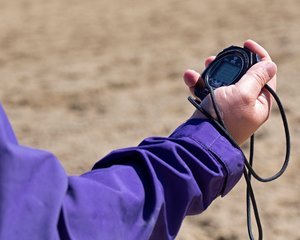Aqueduct's Training and Stabling to Shift to Belmont


The New York Racing Association announced Dec. 12 all stabling and training of racehorses will be shifted from Aqueduct Racetrack to Belmont Park as of Jan. 1.
"As this change takes effect, we appreciate the patience and understanding of horsemen who utilized Aqueduct as a primary base of operations," said Glen Kozak, NYRA's vice president of facilities and racing surfaces. "The consolidation of NYRA's winter training activities to Belmont Park follows years of barn renovations and new construction, resulting in a facility that now features 2,500 stalls and can easily accommodate the relatively small number of horses who previously resided at Aqueduct, as well as the 1,200-1,300 horses generally stabled at Belmont during the winter months."
According to NYRA, Belmont provides multiple training options for a variety of weather conditions, particularly during the winter months. Belmont features a one-mile training track, which was fully renovated and significantly widened in 2016, as well as two covered jogging barns, each with a synthetic surface, and a quarter-mile pony track.
"Historically, the vast majority of Aqueduct starters have been stabled at Belmont and ship the short distance (nine miles) to Aqueduct to compete on race day," Kozak said. "That is why NYRA places a great deal of focus on maintaining the Belmont training track in a way that is consistent with the surface at Aqueduct."
NYRA will assume the initial costs associated with the re-stabling of horses and will continue to provide race-day transportation between the two tracks.
Prior to making this decision, NYRA said it consulted with the New York Thoroughbred Horsemen's Association and conducted a full analysis of the main track at Aqueduct to ensure the surface quality and consistency would not be compromised in any way. This analysis was performed by both NYRA and the Racing Surfaces Testing Laboratory.
As for the effect on horsemen, NYTHA president Joe Appelbaum said his organization is monitoring the situation.
"NYTHA is observing the situation keenly, especially as a safety and welfare issue. There will be a number of horsemen dislocated in the middle of winter, which is not ideal, but it is the reality. NYRA seems to be taking all the right steps to accommodate those horsemen, and we will hold them to it," Appelbaum said. "We have horses at Belmont all the time. It's nothing new. The horsemen will make the best of the situation. New York horsemen are used to operating under difficult circumstances, and I'm sure they will overcome any issues here as well."
Appelbaum said the move could also have a financial impact on some horsemen.
"For some of the smaller guys moving from Aqueduct, there's some added costs for shipping and calculating wage rates, so there will be some additional costs," he said.
In response to NYRA's decision, a group of horsemen circulated a petition detailing concerns about equine safety.

Mick Peterson, executive director of the RSTL, applauded the decision to consolidate training to Belmont.
"The Aqueduct main track and the Belmont training track are identical in design and well suited to winter use," Peterson said. "The design helps facilitate the maintenance required to address weather challenges. As with any surface, the key is consistency, and the all-weather availability of the Belmont training track is a huge plus."
Peterson cited significant safety benefits for shifting winter training to NYRA's Elmont, N.Y., facility.
"In particular, if NYRA encounters changing winter weather conditions, then decisions related to the maintenance of the track can be made based on what is needed to prepare the track for racing," Peterson added. "This will allow, for example, a track that is harrowed overnight to avoid freezing to be floated in the morning as it warms up to keep rain out of the cushion."
NYRA consults and actively shares internal data and daily measurements with leading independent testing and engineering firms to provide additional levels of scrutiny and relevant expertise. All track maintenance work is meticulously documented, logged, and subsequently shared in real time, both internally and with outside consultants.
The Belmont training track is open daily from 5:30-10:30 a.m. ET with renovation breaks at 7:15 a.m and 9 a.m. The covered jogging barns and pony track are open daily from 5:30-10:30 a.m.
NYRA provides a full complement of outriders and safety personnel to monitor morning training at each location. Winter training coverage is consistent with the busiest periods during the spring and summer.
The Oklahoma training track at Saratoga Race Course, which is closed for the winter, will open for training in April. The 40-day summer meet at Saratoga runs from July 16 through Sept. 7.
Additional reporting by Bob Ehalt
